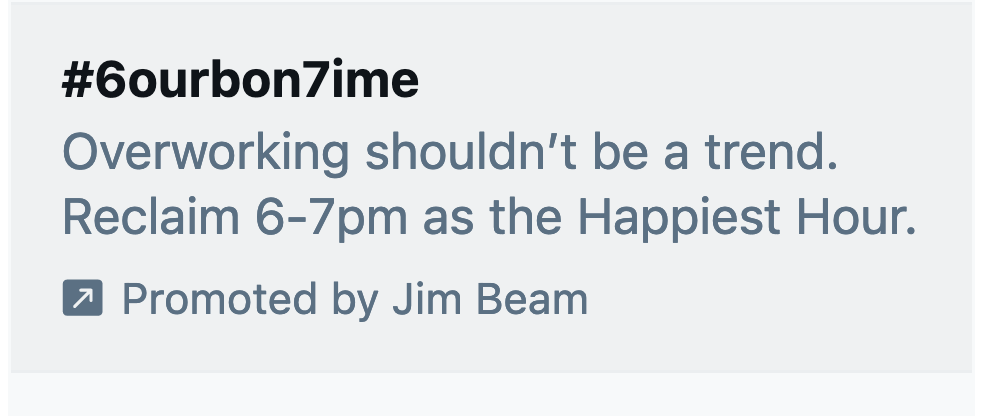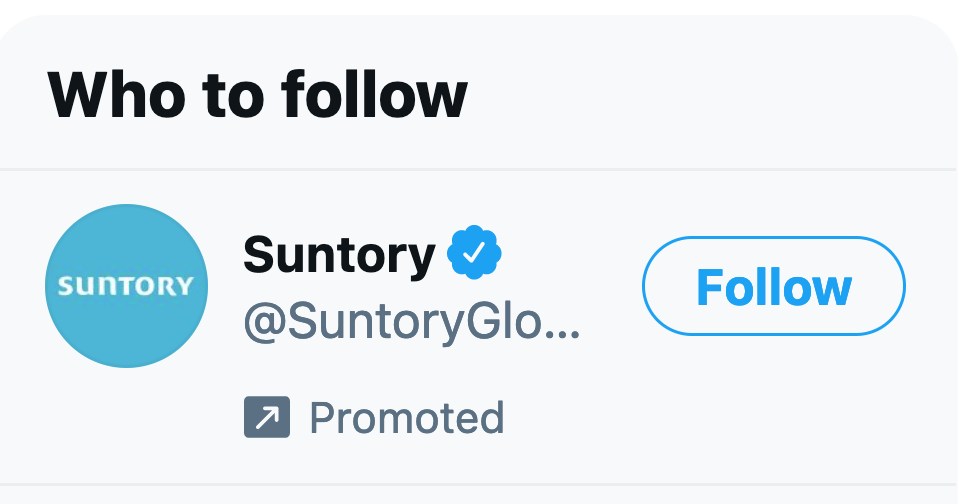I quit drinking a bit more than three years ago. I wrestle with terms – I had a fairly easy time quitting, which makes me wonder whether “alcoholic” is the right word for me, but “problem drinker” certainly describes my experience. I liked drinking alcohol, and I had a hard time stopping once I started. I did things I regret when drunk, damaged relationships, mistreated friends and abused my body. I am proud of my sobriety and hope to stay on this path in perpetuity.
Unlike some people who stop drinking, I haven’t removed all the alcohol from my house. My partner has an occasional glass of wine and back when we could have friends come to visit, we’d have wine and beer around for guests. But there’s no bourbon in my house because that was my special poison. I got drunk on big cups full of diet pepsi and Jim Beam, sipped in front of the TV to relax at the end of the long day. Almost every day was a long day.
So this ad on Twitter is tough for me.

Put aside for the moment the whole question of whether it’s appropriate for Jim Beam to appropriate the language of self-care to promote their liquor. I don’t want to see this ad. It’s not good for me to see this ad. I would argue that it’s not even good for Jim Beam for me to see this ad – I am not the sort of responsible Jim Beam consumer the brand claims to be seeking out.
I block ads with Ghostery on Firefox, but Twitter’s ads come through. I’m okay with that – I would prefer a world where I could pay Twitter for their service, but I appreciate that Twitter makes it easy to block individual advertisers… and I block many of them. But this isn’t a conventional ad – it’s a promoted Trending Topic.
Several people have suggested that I might turn off the ad by disabling personalization – I’ve done so. The ad persists. How about blocking the specific advertiser? I did that too – it involves going specifically to Jim Beam’s profile page and blocking them. Not that much of a problem for me, but I can imagine people in recovery for whom that step would have been difficult and unpleasant. But it doesn’t actually remove the promoted trending topic – it’s still there when I reload Twitter after blocking Jim Beam.
Other platform companies have evidently realized that alcohol ads can be problematic. Facebook’s Ad Preferences page includes an Ad Topics section where you can choose to see fewer alcohol ads (but won’t promise to eliminate them.) Google offers a similar feature, and when you choose to see fewer, it offers “we’ll try not to show ads from this category”.
Not Twitter, though. My deep dive into Twitter’s ad settings has led me to retrieve a 47-page long list of advertisers who may reach me because the ad data it has on me is similar to the audiences these advertisers are targeting. Several are liquor companies, and I’ll block them all individually as well. But given that blocking Jim Beam entirely hasn’t stopped this ad – ahem, sponsored trending topic – I don’t have great confidence that this will work.
Here’s a dark twist in all this – because I tweeted about the problem seeking help in stopping alcohol ads on Twitter, and because people have responded talking about their problems with alcohol ads, I’m now getting alcohol brands in my lists of accounts to follow. Don’t like being advertised to by Jim Beam? For a relaxing time, try Suntory time.

Alcoholics and problem drinkers aren’t the only ones who face this problem. In writing about this, people have pointed out how horrible it is to experience a miscarriage and then be targeted with baby product ads. Advertising, in general, can be triggering, whether it’s the Father’s Day ad after your dad’s death, or Valentine’s Day after a breakup. What’s tricky is that targeted advertising promises that we can avoid inappropriate and harmful ads and optimize for what we want and need. It’s a promise that often falls short.
To Twitter’s enormous credit, Twitter’s revenue product lead contacted me within an hour of posting about the problem: “Hi Ethan, thank you for the feedback and great suggestion. Will look into getting something like this built.” Twitter gets credit for using their own tool, following online discussions and responding to suggestions. I hope Twitter will a) make it possible to block or mute sponsored trending topics and b) include a global “no alcohol for me” feature, understanding that mistakes happen, etc.
We have a funny relationship with alcohol in our society. A few months back, I did a small favor for a national philanthropic organization. To say thanks, they sent a bottle of very good small batch bourbon to my house, hand-delivered by a local retailer – no card, so I didn’t know who’d sent me the bottle or why. I was so surprised, I accepted the bottle from the deliveryman, wordlessly, and brought it inside. I had trouble sleeping that night, thinking about how lovely that particular bourbon tastes. The next morning, I drove the bottle 15 miles to the liquor store that had delivered it, handed it back, and asked them please to take it. My hands were shaking, and I explained that, as nice as the gift was, I simply couldn’t have it in my house.
I know I’ve brought alcohol to someone’s house not knowing whether drinking was a problem for them simply because alcohol is a default gift in our society. I suspect that whoever approved the Happy Hour campaign on Twitter for Jim Beam didn’t think that it would lead to shaking hands for at least a few of us who saw the ads. One aspect of contemporary society that gives me some hope for the future is that we seem to be getting better at understanding that what’s okay for us might be very harmful for someone else. Here’s hoping Twitter and other companies will make it easier for those of us who are trying to care for our alcohol problems to have a safe and sober happy hour at the end of a long day.